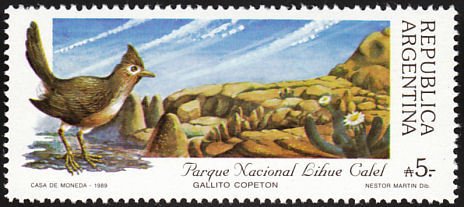Stamp: Lihue Calel National Park - Crested Gallito (Rhinocrypta lan (Argentina 1989)
Lihue Calel National Park - Crested Gallito (Rhinocrypta lan (Argentina 1989)
06 May (Argentina ) within release National parks goes into circulation Stamp Lihue Calel National Park - Crested Gallito (Rhinocrypta lan face value 5 Argentine austral
| Stamp Lihue Calel National Park - Crested Gallito (Rhinocrypta lan in catalogues | |
|---|---|
| Michel: | Mi:AR 1962 |
| Götig and Jalil: | Göt:AR 2438 |
Stamp is square format.
Also in the issue National parks:
- Stamp - El Palmar National Park - Lizard face value 5;
- Stamp - Calilenga National Park - Brazilian Tapir (Tapirus terrestri face value 5;
- Stamp - Chaco National Park - Black Howler (Alouatta caraya) face value 5;
- Stamp - Los Glaciares National Park - Magellanic Woodpecker (Campeph face value 5;
- Stamp - Lihue Calel National Park - Crested Gallito (Rhinocrypta lan face value 5;
Stamp Lihue Calel National Park - Crested Gallito (Rhinocrypta lan it reflects the thematic directions:
Birds (Aves), a subgroup of Reptiles, are the last living examples of Dinosaurs. They are a group of endothermic vertebrates, characterised by feathers, toothless beaked jaws, the laying of hard-shelled eggs, a high metabolic rate, a four-chambered heart, and a strong yet lightweight skeleton. Birds live worldwide and range in size from the 5 cm (2 in) bee hummingbird to the 2.75 m (9 ft) ostrich. They rank as the class of tetrapods with the most living species, at approximately ten thousand, with more than half of these being passerines, sometimes known as perching birds. Birds are the closest living relatives of crocodilians.
In geology, rock (or stone) is any naturally occurring solid mass or aggregate of minerals or mineraloid matter. It is categorized by the minerals included, its chemical composition, and the way in which it is formed. Rocks form the Earth's outer solid layer, the crust, and most of its interior, except for the liquid outer core and pockets of magma in the asthenosphere. The study of rocks involves multiple subdisciplines of geology, including petrology and mineralogy. It may be limited to rocks found on Earth, or it may include planetary geology that studies the rocks of other celestial objects.


